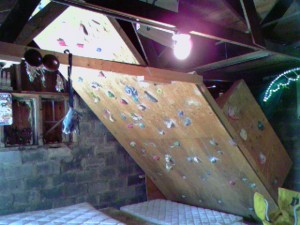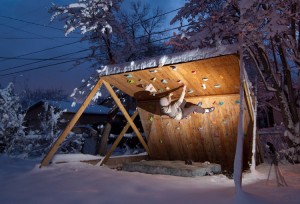A common question is what angle to build your climbing wall. Below is a run-down of different angles and why you may or may not want one or another.
Each situation is different you want to make a wall that fits your needs/resources/space/etc. Always take into consideration the following before picking angle:
- Space: Often the dictator of the wall. Where, how big, can you fit multiple angles, multiple walls, roof, etc?
- Skill Level: different skill levels will use the wall differently. A new climber is different from a advanced climber looking for specific training and will want different walls.
- User group: Taylor the wall to fit the user group. If you want a bunch of people to climb on your wall it may require a different angle set-up then a single user. Or if you are building for your 10 yr old kid that is different then someone adding this to this college house.
- Difficulty of Build: Some angles are easier to build then others and require more/less materials.
HOW TO MEASURE WALL ANGLE:
- This is a little weird and takes time to understand. When I say it is a 30 degree wall, it means that it is overhanging 30 degrees. However when you input it into a triangle you are calculating the inverse: Angle BCA will be 60 degrees (as the inverse of that which is the overhanging part is 30 degrees).
- Check it out here: http://www.visualtrig.com/
- Input 10 in the yellow box – Side A (which will represent 10 vertical feet)
- Input 60 degrees in the green box – Angle C (which will represent the inverse of the angle of the wall)
- Should look like a normal wall with the wall being the long side (side c)
0 Degree’s, perfectly vertical wall:
Pros: Easiest angle to build, fits anywhere, great for little kids, every hold known to mankind can work on it, great for working on technique and slab-type problems.
Cons: Will become extremely boring very quick, not very challenging, not very interesting
Should you Build This: For a home woody with limited space and resources it is recommended that you DO NOT build a vertical wall. In a commercial gym it makes sense as a way to cater to brand-new climbers, tricky slab-climbing, and specific holds, but a home gym is for training and personal enjoyment and a big vertical wall will become uninteresting way too fast. If you absolutely need vertical try to incorporate it in a small section or build a specific volume to allow for holds like the Boss to be used.
Slightly Overhanging wall, 10-20 Degrees:
Pros: Better then a pure-vertical wall.
Cons: Again this is a easy angle that most climbers will not be challenged by. Holds will need to be small and painful.
Should you build this: Most likely not. In the real-world of outdoor rock climbing most sport/trad routes fall into this level of overhang with is much more challenging when it is 50+ feet long, however over 12-16 feet this angle will quickly become mastered by most climbers. You may want a section at this angle, however you do not want the majority of your wall at this angle. 10-20 degrees will feel a lot like Vertical after a while. Best solution: 35 degree wall transitioned into a 15 degree top-out (or vice-versa).
Pros: Probably the most versatile angle, most climbing holds are made for this angle, beginners to advanced climbers can use the same wall and only holds/moves would be different.
Cons: Conformity to every other home woody out there.
Should you build this: All wall designs should incorporate this angle unless you are looking for something more specific.
Important Note: While you should strive for a 35 degree wall in reality when building your wall you don’t need to specifically measure the angle. Ideally when selecting this angle it is less steep then 45 degrees but more steep then 15-20 degrees. Essentially anything from 20-40 degrees is the sweet spot.
45 Degree Wall (steep/overhanging):
Pros: This angle provides a serious workout even if you are just hanging on jugs. Great angle for the popular system work-outs. More advanced.
Cons: For beginners holds will need to be good sized jugs which usually means spending a lot more money.
Should you build this: Depending on skill-set this may be a viable option on your wall. As the only angle it may challenge beginners too much or require a lot of different holds as you progress. Can be a fun angle and due to the angle means you can put a lot of surface area in a small space (11-12 ft of surface in 8 ft of height).
Roof/Severely Overhanging:
Pros: Specific strength exercises.
Cons: Specific strength exercises.
Should you Build this: These are great additions to an existing angle as a transition to the end of the climb. So if you are looking to add some spice to your wall do this at the end. Even if it is just a 3 ft extension it will add a lot to finishing moves on your wall.
Less then Vertical:
Should you Build this: No
[important] Continue to Learn More for Wall Planning[/important]
- Planning Your Climbing Wall
- What Angle to Build your Wall
- ROI of a Wall
- Building Your Climbing Wall
- Home Climbing Walls vs Commercial Climbing Gyms
- My Climbing Walls and Construction Details




Recent Comments